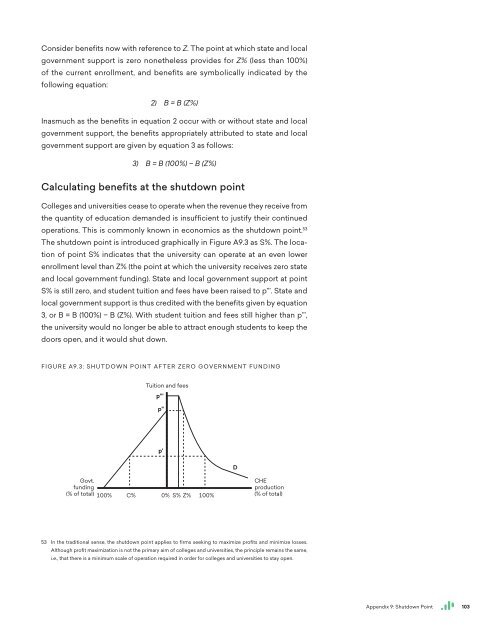The Economic Value of WTAMU Main Report
This report assesses the impact of West Texas A&M University (WTAMU) on the regional economy and the benefits generated by the university for students, taxpayers, and society. The results of this study show that WTAMU creates a positive net impact on the regional economy and generates a positive return on investment for students, taxpayers, and society.
This report assesses the impact of West Texas A&M University (WTAMU) on the regional economy and the benefits generated by the university for students, taxpayers, and society. The results of this study show that WTAMU creates a positive net impact on the regional economy and generates a positive return on investment for students, taxpayers, and society.
You also want an ePaper? Increase the reach of your titles
YUMPU automatically turns print PDFs into web optimized ePapers that Google loves.
Consider benefits now with reference to Z. <strong>The</strong> point at which state and local<br />
government support is zero nonetheless provides for Z% (less than 100%)<br />
<strong>of</strong> the current enrollment, and benefits are symbolically indicated by the<br />
following equation:<br />
2) B = B (Z%)<br />
Inasmuch as the benefits in equation 2 occur with or without state and local<br />
government support, the benefits appropriately attributed to state and local<br />
government support are given by equation 3 as follows:<br />
3) B = B (100%) − B (Z%)<br />
Calculating benefits at the shutdown point<br />
Colleges and universities cease to operate when the revenue they receive from<br />
the quantity <strong>of</strong> education demanded is insufficient to justify their continued<br />
operations. This is commonly known in economics as the shutdown point. 53<br />
<strong>The</strong> shutdown point is introduced graphically in Figure A9.3 as S%. <strong>The</strong> location<br />
<strong>of</strong> point S% indicates that the university can operate at an even lower<br />
enrollment level than Z% (the point at which the university receives zero state<br />
and local government funding). State and local government support at point<br />
S% is still zero, and student tuition and fees have been raised to p’’’. State and<br />
local government support is thus credited with the benefits given by equation<br />
3, or B = B (100%) − B (Z%). With student tuition and fees still higher than p’’’,<br />
the university would no longer be able to attract enough students to keep the<br />
doors open, and it would shut down.<br />
FIGURE A9.3: SHUTDOWN POINT AFTER ZERO GOVERNMENT FUNDING<br />
Tuition and fees<br />
p'''<br />
p"<br />
p'<br />
D<br />
Govt.<br />
funding<br />
(% <strong>of</strong> total)<br />
100% C% 0% S% Z% 100%<br />
CHE<br />
production<br />
(% <strong>of</strong> total)<br />
53 In the traditional sense, the shutdown point applies to firms seeking to maximize pr<strong>of</strong>its and minimize losses.<br />
Although pr<strong>of</strong>it maximization is not the primary aim <strong>of</strong> colleges and universities, the principle remains the same,<br />
i.e., that there is a minimum scale <strong>of</strong> operation required in order for colleges and universities to stay open.<br />
Appendix 9: Shutdown Point<br />
103





